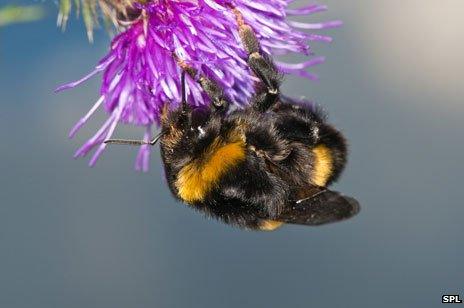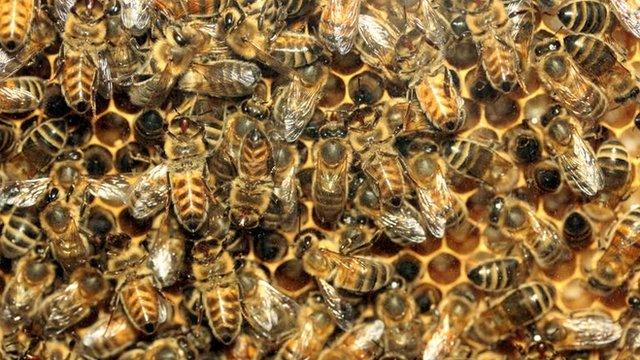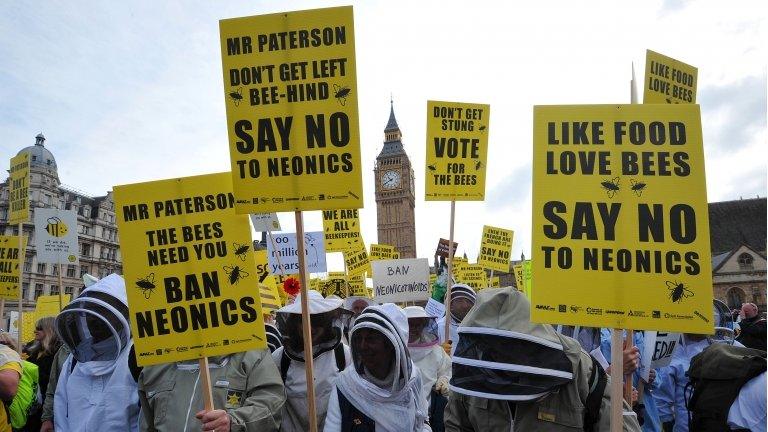Bees on their knees while bed bugs boom
- Published
- comments

Bed bugs are often found in hotels having spread rapidly around the world over the past 20 years
I am writing this while desperately resisting the temptation to have a decent scratch at the countless raised red bumps on my arms, ankles and neck.
These weals of misfortune are not a reaction to some new body art. Instead they are proof positive of the power of unintended consequences when it comes to humans and the environment.
I have been attacked by Cimex lecturlarius, more commonly known as the not so humble bed bug. And it's not my only brush with the blood sucking hordes. The first time was after a stay in a hotel in Toulouse (To-louse?).
This time in Sicily, they once again, made me an offer I couldn't refuse.
The inconvenience of rejoining the itchy and scratchy show, has left me thinking about how our great plans for controlling and protecting the natural world can end up biting us in the most painful of places.
The rise of bed bugs, external across the world is attributed to a number of causes especially the increase in global air travel. But another key factor was the decision taken in the 1980s to restrict the use of powerful insecticides such as DDT and chlordane, external.
Bed mates
Since the end of World War II the widespread use of these powerful sprays almost wiped out bed bugs, but they also took a terrible toll on human health and on species species including eagles and ospreys, external.
Since the ban, the bugs have boomed, emerging from the shadows to prey on the warm bodies of unsuspecting travellers across the world.
It's not the only example of unintended consequences. Our modern world is full of them.
Wind turbines that are a source of clean, green energy are also having an unforeseen impact on bats and birds. In California the building of desert based solar power plants has caused outbreaks of valley fever, external among workers, infected by spores that have emerged from the disturbed soil.

Will the neonicotinoids ban leave bees vulnerable to other threats?
Anecdotal evidence suggests that in the Ebro region of Spain, external, there have been efforts to attract more birdwatchers by spraying insecticide to kill off the hordes of flies and mosquitoes that make outdoor activities unbearable.
But these efforts to attract more twitchers are contributing to the decline of the very same species they come to see, because the birds feed on the frogs who feed on the flies that are now being killed off in huge numbers.
I wonder if the same fate lies in store for another species who have, in their time, also given me a few venomous pointers on insect behaviour.
Humble bees, bumble and otherwise, have been much in the news as a result of an EU decision to temporarily ban the use of neonicotinoid pesticides.
The move has been hailed as an historic breakthrough by campaigners and many scientists concerned about the role of the chemicals in the decline of these popular pollinators.
Others, though, are worried that the rush to do something might backfire in a number of ways, external.
Because neonicotinoids are coated on seeds they avoid the need for farmers to spray their fields, lessening the chemical impact on the wider environment.
But even though they are to be banned, pharmaceutical companies might be unlikely to develop similar coated products for a market that might close in two years.
According to Dr Julian Little from Bayer, it takes 10 years and approximately £300m to move a new pesticide from discovery to market.
"There are no new seed treatments to be magicked out of the hat," Dr Little tells me.
"In their absence, farmers tell us that they will be forced to return to old chemistry to spray - and we presume they will have to resort to more pyrethroid spray use."
These are older chemicals which can be carcinogenic to humans and are well known for having a range of impacts, external on the environment as well as being toxic to bees.
Given the cocktail of ailments, external that afflict bees, it could potentially make their survival more difficult.
It would be a very colourless, hungry and and rather irritated world if bees continued to decline while dull-but-hardy bed bugs thrive.
Let's hope that over the next two years researchers will be able to use the EU moratorium to prevent that happening.
Follow Matt on Twitter, external.
- Published23 April 2013

- Published26 April 2013
